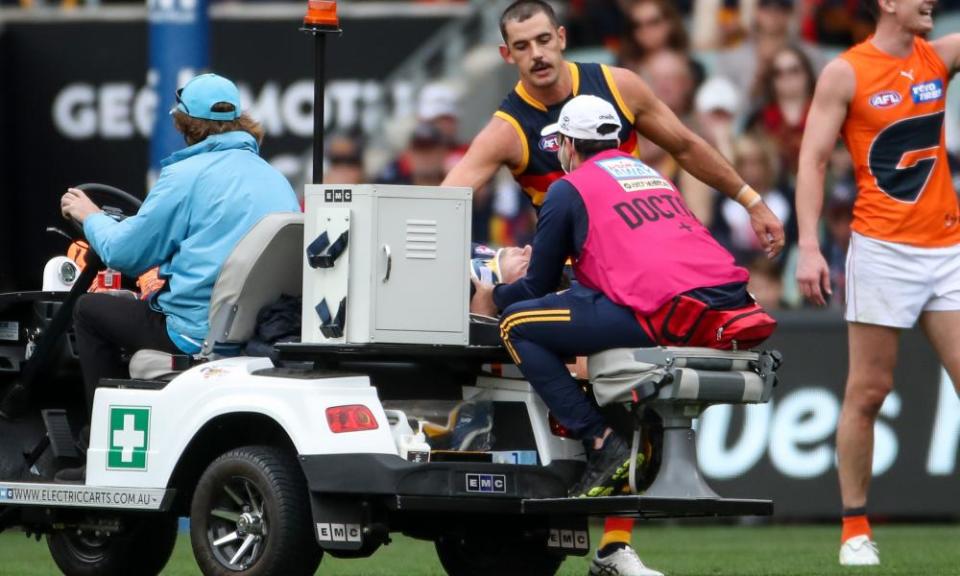AFL acknowledges link between head trauma and CTE, in submission to Senate concussion inquiry

The AFL has acknowledged the link between head trauma and the serious neurodegenerative disease, chronic traumatic encephalopathy (CTE), ahead of its appearance at a Senate committee hearing next month.
In a submission to the ongoing inquiry into concussions and repeated head trauma in contact sports, the AFL said it “supports and adopts” the recent statements by the US National Institutes of Health (NIH) that accept the link between CTE and head trauma, and were described by campaigners as a tipping point in the debate about the risks of playing contact sport.
“The AFL acknowledges that there is an association between head trauma and neurodegenerative disease (including chronic traumatic encephalopathy – neuropathological change [CTE-NC]),” the submission said.
“The AFL is committed to furthering and supporting research into an increased understanding of concussion (and repeated head impacts), neurodegenerative disease and CTE-NC as may exist in our sport and more generally.”
Related: Is this Australia’s turning point for concussion in sport? | Full Story podcast
The NIH position is at odds with the position held by the global Concussion in Sport Group (CISG), the most recent published statements from which argue – counter to the growing body of scientific evidence – that a cause-and-effect relationship “has not yet been demonstrated” between CTE and concussion or exposure to contact sports.
The CISG is supported by the AFL, along with other major sporting codes such as the NRL, World Rugby, Fifa and the IOC, among others.
The AFL’s submission release comes just two weeks after the league released updated concussion guidelines for its elite levels and a new four-year strategic plan for management of concussion.
It also comes close on the heels of two class-action lawsuits filed by former players. One features more than 60 former players who sustained concussions during their careers, led by erstwhile Geelong player Max Rooke, and another led by Katherine Tuck, the wife of late Richmond player Shane Tuck, who was one of numerous former players found to have had CTE after his early death .
Sign up for Guardian Australia’s free morning and afternoon email newsletters for your daily news roundup
The AFL said it was making “no substantive submission” to the inquiry’s terms of reference regarding the liability of sporting associations for long-term impacts of concussion and repeated head trauma, except that it was “comfortable” that it had played its role “consistent with applicable duties of care”.
The submission detailed other concussion mitigation strategies the league was undergoing, such as providing annual player presentations on concussion that outlined “potential long-term outcomes that may result from concussion and/or repeated head impacts” which included “risk of neurodegenerative diseases including chronic traumatic encephalopathy”.
Related: Concussion dominates headlines as NRL and AFL seasons get under way | Stephanie Convery
However, the submission said the prevalence of CTE in contact sports “remains unclear”, despite acknowledging a study by the Sydney Brain Bank that found a prevalence of less than 1% among 636 members of the general population. Preliminary findings released by the Australian Sports Brain Bank early last year, examining the brains of 21 sportspeople donated since the centre’s inception in 2018 found CTE in more than half of them, including in three people under the age of 35.
The AFL argued “the association between head trauma and long-term psychological health” was similarly unclear.
The AFL’s admission of the link between head trauma and CTE follows those by representatives from the NRL and Football Australia in March hearings.
In its submission to the Senate inquiry, the AFL said its concussion guidelines, like those of most major sporting codes including the NRL, World Rugby and others, are a “pragmatic translation” of the CISG consensus statements.
In October last year, the AFL apologised to players who it said were “let down” after it funded a massive study which promised to make “groundbreaking” findings about concussion but resulted in no published research and “confusion” about what happened to tests performed on players.
The apology came after the league held a review into the work of neurologist and former AFL concussion adviser Dr Paul McCrory, who had been responsible for the study.
Related: Guardian Australia wins Quill award for investigation into concussion and the AFL
McCrory was an influential figure in the CISG and lead author of four of the five global consensus statements on management of concussion in sport that guide field-side treatment of the injury around the world. McCrory stood down as chair of the CISG in March last year after the British Journal of Sports Medicine (BJSM) retracted one of his 2005 editorials after allegations of plagiarism.
At the time McCrory was quoted apologising on website Retraction Watch, saying his failure to attribute the work of another researcher was an error and “not deliberate or intentional”. The AFL review found that the identified instances of plagiarism by McCrory “[did] not affect or taint the work that associate professor McCrory had undertaken for the AFL, in particular the AFL’s guidelines on concussion, in large part because they do not involve the falsification or fabrication of relevant research”.
The BJSM has since retracted nine of McCrory’s articles for plagiarism and self-plagiarism and placed concerns notices on a further 74.
Since a review last year, the AFL said its elite past player program was undergoing a “substantive restructure”.
More than half a million Australians were registered players in Australian rules football last year, from children as young as five to adults.
The AFL is expected to give evidence to the Senate committee at a hearing in Melbourne on 26 April.
This story was corrected on 28 March 2023 to clarify that studies referenced are from the Sydney Brain Bank and the Australian Sports Brain Bank.

 Yahoo Sport
Yahoo Sport 





































